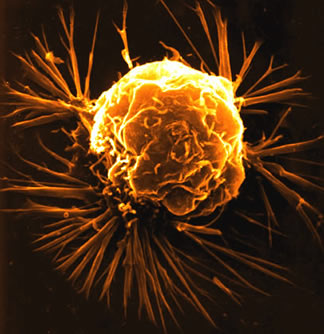Using fruit flies as a model, researchers in Spain believe they have uncovered the individual steps that normal cells go through when they become cancerous and spread. Because the vast majority of genes in Drosophila melanogaster are the same in mice and humans, the researchers suggest the fruit fly offers an inexpensive and effective model for observing cancer at the molecular level, and hope other scientists can use their results to study the individual molecules and stages in particular cancers.
In a paper on their work published online recently in the Proceedings of the National Academy of Sciences, PNAS the authors, from the Institute for Research in Biomedicine (IRB), and the Catalan Institute for Research and Advanced Studies (ICREA), both in Barcelona, describe how they introduced genetic errors in selected cells in the fly's wing and followed their progress step by step as they became cancerous and spread. First author Andrés Dekanty, explains in a statement, how "for the first time": "... we have a genetic model that allows us to understand the events that take place, starting from when cells begin to accumulate genomic errors until the development of a tumor."
Step By Step: From Genomic Instability to Invading Nearby Tissue
Dekanty and colleagues started by provoking genomic instability (in this case by creating an abnormal number of chromosomes, or aneuploidy) in a selection of cells in the fly's wing. In healthy tissue, this kind of instability usually triggers defence mechanisms such as cell suicide. But the researchers blocked these triggers so the defective cells could survive and go on to become cancerous. They observed how the "rogue" cells then went on to spread throughout the tissue of the fly wing, became mobile, activated the growth of nearby cells, and destroyed the membrane that normally anchors them in place. Once free, the cancerous cells then invaded nearby tissue. Senior author Marco Milán explains the value of such a model: "All of these events are things that we see in cancer. This fly model will therefore help us to identify each of the genes and molecules involved in epithelial cell detachment (delamination), motility, abnormal growth, basal cell degradation and invasion".
 Is Genomic Instability a Cause of Cancer?
Is Genomic Instability a Cause of Cancer?But the researchers say their findings go further than offering a model; they inform a "fundamental conceptual debate" about the role of genomic instability in cancer. The genomes of human cancer cells are full of mistakes. Milán says their study now allows scientists to investigate the question: is genomic instability itself a cause of cancer (tumorigenesis)? "If we can demonstrate this direct correlation, we will have something very specific to work with to find precise targets," he adds. "Aneuploid cells don't exist in healthy organisms. If we can identify what differentiates a cell with genomic instability from a normal cell, we may be able to identify specific treatments," explains Dekanty.
Hope for Drugs that Allow Healthy Cells to Divide
The goal of current cancer treatments is to slow down cell proliferation or division. The problem with such an approach is that it targets all cells that divide, both healthy and cancerous. This is what gives rise to so many unpleasant side effects. If it were possible to single out the cells with genomic instability and target only those, it would be a major step forward: "we'll hopefully be able to find drugs that target them specifically", explains Dekanty. Fruit flies are also helping to uncover molecular mechanisms in other areas of research. For instance, in October this year, researchers at Brown University and the University of California-Irvine revealed how they created a Drosophila fruit fly model of epilepsy to discover the mechanism by which temperature-dependent seizures happen.
Source:http://www.medicalnewstoday.com/articles/253597.php




